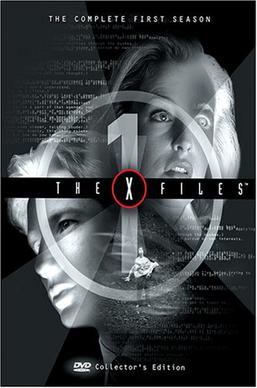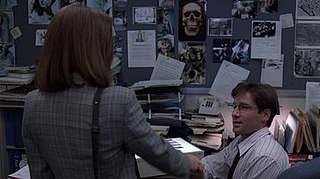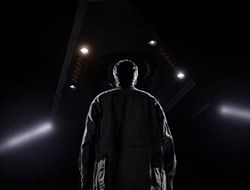
The first season of the science fiction television series The X-Files commenced airing on the Fox network in the United States on September 10, 1993, and concluded on the same channel on May 13, 1994, after airing all 24 episodes.

The second season of the science fiction television series The X-Files commenced airing on the Fox network in the United States on September 16, 1994, concluded on the same channel on May 19, 1995, after airing all 25 episodes. The series follows Federal Bureau of Investigation special agents Fox Mulder and Dana Scully, portrayed by David Duchovny and Gillian Anderson respectively, who investigate paranormal or supernatural cases, known as X-Files by the FBI.

The third season of the American science fiction television series The X-Files commenced airing on Fox in the United States on September 22, 1995, concluded on the same channel on May 17, 1996, and contained 24 episodes. The season continues to follow the cases of FBI special agents Fox Mulder and Dana Scully, portrayed by David Duchovny and Gillian Anderson respectively, who investigate paranormal or supernatural cases, known as X-Files by the FBI.

"Pilot" is the pilot episode of the science fiction television series The X-Files. The episode aired on September 10, 1993, on the Fox network in the United States and Canada, and subsequently aired in the United Kingdom on BBC Two. The episode was written by series creator Chris Carter, and directed by Robert Mandel. As the pilot, it would set up the mythology storyline for the series. The episode earned a Nielsen rating of 7.9 and was viewed by 7.4 million households and 12.0 million viewers. The episode itself was generally well received by fans and critics alike, which led to a growing cult following for the series before it hit the mainstream.

"Deep Throat" is the second episode of the first season of the American science fiction television series The X-Files. This episode premiered on the Fox network on September 17, 1993. Written by series creator Chris Carter and directed by Daniel Sackheim, the episode introduces several elements which became staples of the series' mythology.
"The Jersey Devil" is the fifth episode of the first season of the American science fiction television series The X-Files, premiering on the Fox network on October 8, 1993. It was written by series creator Chris Carter, directed by Joe Napolitano, and featured guest appearances by Gregory Sierra, Wayne Tippit and Claire Stansfield. Although the episode is the series' second "Monster-of-the-Week" story—after the earlier "Squeeze"—it was the first to have been written by Carter.
"Shadows" is the sixth episode of the first season of the American science fiction television series The X-Files, premiering on the Fox network on October 22, 1993. It was written by Glen Morgan and James Wong, directed by Michael Katleman, and featured guest appearances by Barry Primus and Lisa Waltz. The episode is a "Monster-of-the-Week" story, unconnected to the series' wider mythology. "Shadows" earned a Nielsen household rating of 5.9, being watched by 5.6 million households in its initial broadcast. The episode was not well-received by the production staff and received mixed reviews from critics.
"Ice" is the eighth episode of the first season of the American science fiction television series The X-Files, premiering on the Fox network on November 5, 1993. It was directed by David Nutter and written by Glen Morgan and James Wong. The debut broadcast of "Ice" was watched by 10 million viewers in 6.2 million households. The episode received positive reviews at large from critics, who praised its tense atmosphere.
"Gender Bender" is the fourteenth episode of the first season of the American science fiction television series The X-Files, premiering on the Fox network on January 21, 1994. It was written by Larry and Paul Barber, directed by Rob Bowman, and featured a guest appearance by Nicholas Lea, who would later appear in the recurring role of Alex Krycek. The episode is a "Monster-of-the-Week" story, a stand-alone plot which is unconnected to the series' overarching mythology.
"Roland" is the twenty-third episode of the first season of the American science fiction television series The X-Files, premiering on the Fox network on May 6, 1994. It was written by Chris Ruppenthal and directed by David Nutter. The episode featured guest appearances by Željko Ivanek, James Sloyan and Kerry Sandomirsky. The episode is a "Monster-of-the-Week" story, a stand-alone plot which is unconnected to the series' wider mythology. "Roland" earned a Nielsen household rating of 7.9, being watched by 7.4 million households in its initial broadcast; and received mixed reviews from critics, although Ivanek's guest role was met with acclaim.
"Sleepless" is the 4th episode of the second season and 28th overall of the science fiction television series The X-Files, premiering on the Fox network on October 7, 1994. The episode was written by supervising producer Howard Gordon and directed by Rob Bowman. The episode is a "Monster-of-the-Week" story, unconnected to the series' wider mythology, although it features the first on-screen appearances of recurring characters X and Alex Krycek, who are central to the show's continuity. Its closing scene also sets the stage for the subsequent story arc of Scully's abduction. "Sleepless" earned a Nielsen rating of 8.6 and was viewed by 8.2 million households. The episode received mostly positive reviews from critics.
"3" is the seventh episode of the second season of the American science fiction television series The X-Files. First broadcast on the Fox network on November 4, 1994, the episode was written by Glen Morgan, James Wong and Chris Ruppenthal, directed by David Nutter, and featured guest appearances by Perrey Reeves and Malcolm Stewart.

"Die Hand Die Verletzt" is the fourteenth episode of the second season of the science fiction television series The X-Files. It premiered on the Fox network on January 27, 1995. It was written by Glen Morgan and James Wong, directed by Kim Manners, and featured guest appearances by Susan Blommaert, Dan Butler, and Heather McComb. The episode is a "Monster-of-the-Week" story, unconnected to the series' wider mythology. "Die Hand Die Verletzt" earned a Nielsen household rating of 10.7, being watched by 10.2 million households in its initial broadcast. The episode received positive reviews, with many critics praising its writing. The title translates from German as "the hand that wounds."

"2Shy" is the sixth episode of the third season of the American science fiction television series The X-Files. It premiered on the Fox network on November 3, 1995. It was written by Jeff Vlaming, directed by David Nutter, and featured guest appearances by Timothy Carhart and James Handy. The episode is a "Monster-of-the-Week" story, a stand-alone plot which is unconnected to the series' wider mythology.
"Max" is the eighteenth episode of the fourth season of the American science fiction television series The X-Files. It premiered on the Fox network on March 23, 1997. It was directed by Kim Manners, and written by Frank Spotnitz and series creator Chris Carter. "Max" featured guest appearances by Joe Spano, Tom O'Brien and Scott Bellis, and saw the final appearance of Brendan Beiser as special agent Pendrell. The episode helped to explore the overarching mythology, or fictional history of The X-Files. "Max" earned a Nielsen household rating of 11.6, being watched by 18.34 million people in its initial broadcast. The episode received mixed to positive reviews from critics.
"Alone" is the nineteenth episode of the eighth season and the 180th episode overall of the science fiction television series The X-Files. The episode first aired in the United States on May 6, 2001 on Fox, and subsequently aired in the United Kingdom on Sky1 on June 14, 2001. It was written and directed by executive producer Frank Spotnitz. "Alone" earned a Nielsen household rating of 7.5 and was viewed by 12.7 million viewers. It received mixed to positive reviews from television critics.
"E.B.E." is the seventeenth episode of the first season of the American science fiction television series The X-Files, premiering on the Fox network on February 18, 1994. It was written by Glen Morgan and James Wong, and directed by William Graham. The episode introduced the recurring characters of The Lone Gunmen, played by Bruce Harwood, Dean Haglund and Tom Braidwood; and saw Jerry Hardin reprise his role as Deep Throat. The episode helped explore the series' overarching mythology. "E.B.E." earned a Nielsen household rating of 6.2, being watched by 5.8 million households in its initial broadcast; and received positive reviews from critics.
"Tooms" is the twenty-first episode of the first season of the American science fiction television series The X-Files, premiering on the Fox network on April 22, 1994. It was written by Glen Morgan and James Wong, and directed by David Nutter. The episode featured Mitch Pileggi's first appearance as Assistant Director Walter Skinner and saw Doug Hutchison and William B. Davis reprise their roles as Eugene Victor Tooms and the Cigarette Smoking Man, respectively. "Tooms" received positive reviews from critics, and it earned a Nielsen household rating of 8.6, being watched by 8.1 million households in its initial broadcast.









